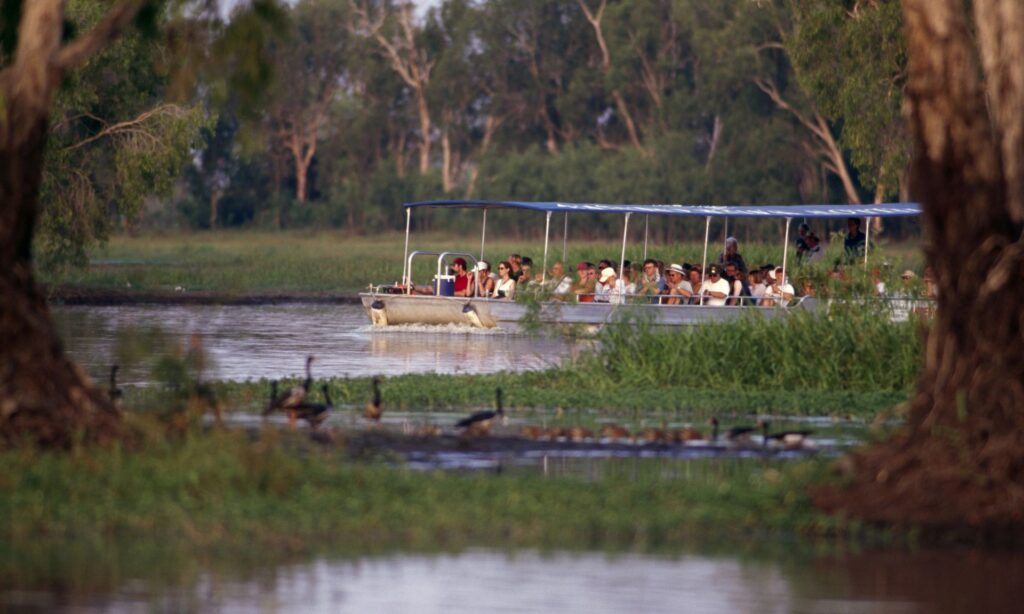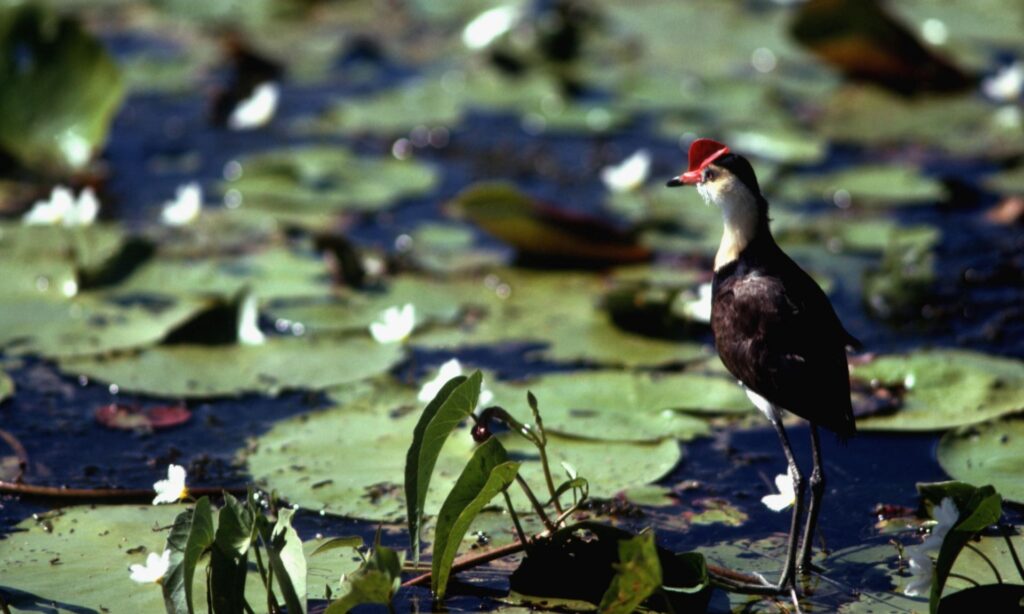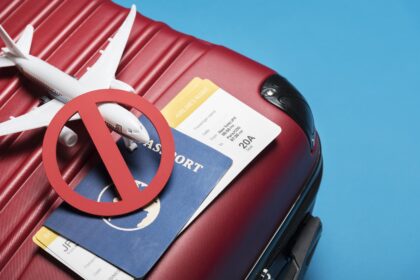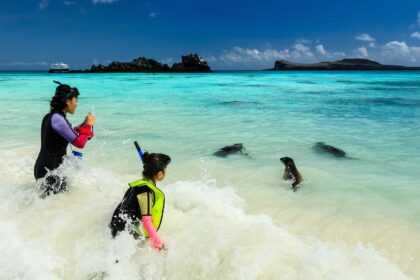Introduction
Kakadu National Park, located in the Northern Territory of Australia, is a sprawling expanse of diverse landscapes, rich cultural heritage, and unique wildlife. For adventure seekers, Kakadu offers a plethora of activities, from exploring ancient rock art to cruising along crocodile-filled waterways. To make the most of your Kakadu adventure, it’s essential to plan carefully and prioritize safety. Here’s a comprehensive travel guide along with safety tips for an unforgettable Kakadu National Park adventure.
Getting There

Air Travel:
The nearest major airport is Darwin International Airport.
From Darwin, you can hire a car or join a guided tour to reach Kakadu, approximately a 3-hour drive.
Road Travel:
Kakadu is accessible by road, and driving allows you to explore the park at your own pace.
Ensure your vehicle is suitable for off-road conditions, especially if you plan to venture into more remote areas.
Things to Do

Explore Ancient Rock Art:
Kakadu is renowned for its ancient Aboriginal rock art, some dating back thousands of years.
Key sites include Ubirr, Nourlangie, and Nanguluwur, offering a glimpse into the rich cultural history of the region.
Wildlife Watching:
Join a guided wildlife cruise to spot crocodiles, birds, and other native species along the waterways.
Birdwatchers will find Kakadu a paradise with over 280 bird species.
Scenic Hikes:
Take on hiking trails like the Nourlangie Rock Walk, Jim Jim Falls, and Barramundi Gorge for breathtaking views and encounters with diverse ecosystems.
Cruise the Yellow Water Billabong:
A cruise on the Yellow Water Billabong offers a unique opportunity to witness Kakadu’s wildlife in their natural habitat, including crocodiles and water birds.
Aboriginal Cultural Experiences:
Engage with the local Indigenous culture by participating in guided tours and cultural experiences.
Respect cultural protocols and seek permission before entering restricted areas.
READ ALSO: Affordable Budget Travel Guide to Australia
Safety Tips

Weather Awareness:
Kakadu experiences extreme weather conditions, including monsoonal rains and scorching heat. Check weather forecasts and plan accordingly.
Crocodile Safety:
Heed warning signs, and stay vigilant near waterways. Crocodiles inhabit many areas, and swimming is not advised in non-designated spots.
Remote Area Preparedness:
If venturing into remote areas, carry sufficient water, food, and fuel. Inform someone of your plans and expected return time.
Emergency Communication:
Mobile phone coverage is limited. Carry a satellite phone or emergency beacon for communication in case of emergencies.
Respect Wildlife and Environment:
Do not feed wildlife, and avoid disturbing the environment. Follow Leave No Trace principles to preserve the park’s natural beauty.
Health Precautions:
Be aware of potential health risks such as heat-related illnesses and insect bites. Carry necessary medications and stay hydrated.
Follow Park Guidelines:
Obey park rules and guidelines to ensure your safety and the preservation of Kakadu’s delicate ecosystems.
A Kakadu National Park adventure promises an immersive experience in one of Australia’s most diverse and culturally rich regions. By following this travel guide and adhering to safety tips, you can make the most of your journey while ensuring a memorable and safe exploration of Kakadu’s wonders. Embrace the natural beauty, connect with Aboriginal culture, and savor the unique adventures that Kakadu has to offer.
Frequently Asked Questions about Kakadu National Park:
Q: What makes Kakadu National Park unique?
A: Kakadu is unique for its vast landscapes, ancient Aboriginal rock art, diverse ecosystems, and rich cultural heritage. It’s home to a variety of wildlife, including crocodiles, and offers a glimpse into Australia’s natural and cultural history.
Q: How do I get to Kakadu National Park?
A: The nearest major airport is Darwin International Airport. From Darwin, you can either drive (approximately 3 hours) or join a guided tour to reach Kakadu National Park.
Q: Are there accommodations within the park?
A: Yes, there are various accommodation options within and around Kakadu National Park, including campgrounds, lodges, and resorts. It’s advisable to book in advance, especially during peak seasons.
Q: What are the must-see attractions in Kakadu?
A: Key attractions include Ubirr, Nourlangie Rock, Jim Jim Falls, Yellow Water Billabong, and various Aboriginal cultural sites. Each offers a unique experience, from ancient rock art to stunning waterfalls and wildlife encounters.
Q: Are there guided tours available?
A: Yes, guided tours are available for various activities such as wildlife cruises, cultural experiences, and hiking. These tours provide insights into the park’s ecology and Aboriginal culture.
Q: Is it safe to swim in Kakadu’s waterholes?
A: Swimming is allowed in designated areas, but caution is advised due to the presence of crocodiles in some waterways. Always adhere to safety signs and guidelines and choose designated swimming spots.
Q: What is the best time to visit Kakadu National Park?
A: The dry season (May to October) is generally considered the best time to visit, with milder temperatures and less rainfall. However, some attractions may be inaccessible during the wet season (November to April).
Q: Are there facilities for camping in Kakadu?
A: Yes, there are campgrounds within the park, ranging from basic to more developed sites. Campers should be well-prepared, as some areas are remote, and facilities may be limited.
Q: Is Kakadu suitable for families with children?
A: Kakadu offers family-friendly activities, but it’s essential to be mindful of safety, especially near waterways. Many tours and attractions cater to families, providing educational and entertaining experiences for children.
Q: Are there entry fees to Kakadu National Park?
A: Yes, there is an entry fee for Kakadu National Park, and it can be paid at park entrance stations. The fee contributes to conservation and maintenance efforts within the park.
Remember that conditions and information may change, so it’s advisable to check with official park sources or visitor centers for the most up-to-date information when planning your visit to Kakadu National Park.
Conclusion
In conclusion, Kakadu National Park stands as a remarkable testament to the natural and cultural wonders of Australia. Its expansive landscapes, ancient rock art, and diverse ecosystems offer visitors a unique and immersive experience. From the rugged beauty of Jim Jim Falls to the cultural richness of Aboriginal sites like Ubirr and Nourlangie Rock, Kakadu is a destination that captures the essence of the Australian outback.
Whether you are an adventure seeker, nature lover, or cultural enthusiast, Kakadu has something to offer. The park’s wildlife, including the iconic crocodile, adds an element of thrill to the experience, while the rich Aboriginal heritage provides a profound connection to the land.
This adventure travel guide and safety tips aim to equip visitors with the necessary information to make the most of their Kakadu journey while prioritizing safety. Whether you choose to explore ancient rock art, cruise along the Yellow Water Billabong, or embark on scenic hikes, being aware of weather conditions, wildlife safety, and park guidelines is crucial for a memorable and secure adventure.
Kakadu National Park invites travelers to delve into the heart of Australia’s natural beauty and cultural heritage. By following the recommended safety measures, respecting the environment, and embracing the unique opportunities for exploration, visitors can create lasting memories while contributing to the preservation of this extraordinary piece of the Australian wilderness. As you embark on your Kakadu adventure, may the landscapes, wildlife, and cultural stories leave an indelible mark on your travel experiences, creating a connection to the timeless spirit of this captivating national park.
In another related article, The Best Adventure Tours in Australia






